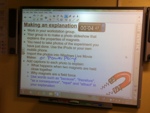
I had my second child recently. Being a parent is one of the steepest learning curves. Learning to be a parent of newborn again has made me reflect on myself as a learner. How do I learn best? I find myself different to many other parents. I don’t like people coming over to visit and “help”. I like to be left alone to try things for myself. The support I find most effective is to be allowed to work it out for myself. If I wanted help I would seek it out myself. I don’t need people to give me hints and advice if I haven’t asked for it. Even as a school student, I would prefer to find the information I need, try it myself first multiple times and then seek help from my teachers after multiple attempts. I hated it when I was forced to listen to the teacher’s ways of doing things step by step.
This got me thinking about personalised and differentiated learning. How can we as teachers design learning experiences to cater to the needs of individual students? A lot of the times personalised and differentiated learning translates to modified learning activities such as assessments, different levels of scaffolding, letting students choose how to present their learning (eg. choosing whether to do a presentation or a poster), allowing students to learn at different paces and creating individual student learning plans. These strategies are necessary and are often very effective but can we push personalised and differentiated learning to another level? Can we allow students to choose HOW they learn?
As teachers, we often force the same way of learning to all of our students, whether it is flipped learning, inquiry learning, traditional teaching, project based learning, etc, etc. In any class there will be some who love whatever strategy the teacher chooses, some who will adapt to any strategy and some who absolute hate the strategy. Also, students can prefer different strategies in different circumstances. Reflecting on my own school experiences, I like to be left to my own devices to work things out in science and maths, but I preferred very structured, teacher-led instruction in art, English and physical education. Talking to students, they have expressed the same views. Some really like the very structured, teacher-led, sage-on-the-stage teaching style of one teacher and others don’t find they learn that way. So is there a way to differentiate and personalise pedagogy for each student?
The answer is probably no (if we are looking at the current schooling model). It will be impractical for one teacher to design a project based learning experience for some students and something else for the rest. However, if we break down the one-teacher-per-thirty-students model, then maybe it can work. If we got rid of the idea of classes and instead took a whole cohort of students (eg. all of year 10) and they had a teaching team (say 6 teachers), then pedagogy can be personalised and differentiated for groups of students. One teacher can lead project based learning experiences for a group. Another can lead a group who like to learn independently. Another can lead a group who like to learn in small groups. The different options can be tailored to the needs of the cohort of students. Students can choose which teacher they would like their learning to be led by based on the pedagogy the teacher will use. This way, teachers can teach to the strategy they are best at and students can learn in the way they prefer.
I haven’t tried this strategy myself or seen it in action. I’d be interested to find out if there are schools who allow students to choose their teachers based on who they think they learn best from based on their teaching strategies.



 Basically the further you are ahead in the race, the power-ups you get never boost your speed. So if you’re coming first, you are only ever given banana peels and turtle shells as power-ups. You leave banana peels on the track so others slip on them or you throw the turtle shell at whoever gets in front of you. You are not given power-ups to get you further ahead. If you’re further behind in the race, the game will give you a range of power-ups like:
Basically the further you are ahead in the race, the power-ups you get never boost your speed. So if you’re coming first, you are only ever given banana peels and turtle shells as power-ups. You leave banana peels on the track so others slip on them or you throw the turtle shell at whoever gets in front of you. You are not given power-ups to get you further ahead. If you’re further behind in the race, the game will give you a range of power-ups like: